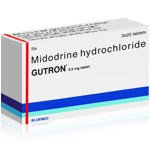Orthostatic Hypotension: Causes, Diagnosis, and Management


Orthostatic hypotension, also known as postural hypotension, is a form of low blood pressure that occurs when an individual stands up from a sitting or lying position. This condition results in inadequate blood flow to the brain, leading to dizziness, lightheadedness, and even fainting. Understanding orthostatic hypotension, its causes, diagnosis, and management, including the role of medications like Gutron, is essential for improving patient outcomes and quality of life.
Initial Management Strategies
The approach to managing orthostatic hypotension involves a combination of lifestyle modifications, medical interventions, and, when necessary, pharmacological treatments. Patients are advised to stand up slowly, especially after sitting or lying down for extended periods. Increasing fluid and salt intake under medical supervision can help expand blood volume and reduce symptoms. Physical counter-pressure maneuvers, such as crossing the legs while standing or tensing the muscles in the lower body, can also be beneficial. In cases where lifestyle changes are insufficient, medications like Gutron may be prescribed.
Common and Underlying Causes
The most common cause of orthostatic hypotension is autonomic dysfunction, particularly in neurodegenerative diseases like Parkinson's disease and multiple system atrophy. These conditions impair the autonomic nervous system's ability to regulate blood pressure. Other causes include dehydration, blood loss, prolonged bed rest, and certain medications such as diuretics, antihypertensives, and antidepressants.
Postural hypotension can also arise from cardiovascular issues, endocrine disorders like diabetes, and neurological conditions that disrupt normal blood pressure regulation. Elderly individuals are at a higher risk due to age-related changes in baroreceptor sensitivity and decreased vascular compliance.
Diagnostic Guidelines and the 10/20/30 Rule
The 10/20/30 rule is a clinical guideline used to assess orthostatic hypotension. It suggests that a drop in systolic blood pressure by 20 mm Hg, diastolic blood pressure by 10 mm Hg, or an increase in heart rate by 30 beats per minute upon standing indicates a significant orthostatic response. This rule aids clinicians in quickly identifying patients who may require further evaluation and intervention.
The formal diagnostic criteria for orthostatic hypotension, as defined by consensus guidelines, include a sustained reduction of at least 20 mm Hg in systolic blood pressure or 10 mm Hg in diastolic blood pressure within three minutes of standing or head-up tilt testing. A thorough patient history, physical examination, and laboratory tests are essential components of the diagnostic process. Additional tests such as autonomic function testing and tilt table testing may be used to further assess the severity and underlying cause of the condition.
Pharmacological Management and the Role of Gutron
Gutron, the brand name for midodrine, plays a significant role in the pharmacological management of orthostatic hypotension. Midodrine is a prodrug that, once metabolized, acts as an alpha-1 adrenergic agonist. This action results in vasoconstriction of blood vessels, thereby increasing vascular tone and raising blood pressure. Gutron is particularly effective in patients with chronic symptomatic orthostatic hypotension who do not adequately respond to non-pharmacological interventions.
Patients prescribed Gutron are typically started on a low dose, which is gradually adjusted based on clinical response and tolerance. The medication is usually administered during the daytime to avoid supine hypertension, a potential side effect characterized by elevated blood pressure while lying down. Common side effects of midodrine include piloerection, scalp tingling, urinary retention, and goosebumps. Regular monitoring by healthcare providers is essential to minimize adverse effects and ensure therapeutic effectiveness.
Patient Education and Emerging Research
In addition to Gutron, comprehensive patient education is critical. Patients should be advised to avoid sudden position changes, remain hydrated, and wear compression stockings if recommended. These measures, combined with medication, can significantly reduce symptoms and improve functional capacity.
Emerging research into orthostatic hypotension focuses on better understanding its pathophysiology and developing more targeted therapies. Studies are examining the genetic and molecular mechanisms underlying autonomic dysfunction and exploring novel drug candidates with fewer side effects. The integration of wearable technologies and home monitoring systems is also being investigated to provide real-time feedback and personalized management strategies for patients.
Advanced Clinical Approaches and Long-Term Outlook
As the understanding of orthostatic hypotension has advanced, clinicians have adopted more nuanced strategies to tailor treatment to individual patients.Multidisciplinary teams comprising neurologists, cardiologists, and physiatrists are increasingly involved in the care of patients with chronic orthostatic hypotension, particularly those with underlying autonomic dysfunction. An integrated approach can help manage comorbid conditions and optimize the patient’s quality of life.
Advanced treatment may involve the cautious use of fludrocortisone, a mineralocorticoid that enhances sodium retention and plasma volume, thereby increasing blood pressure. Its use, however, must be balanced against the risk of fluid overload and hypertension. Pyridostigmine, a cholinesterase inhibitor, has shown promise in certain patient populations by improving neurotransmission in the autonomic ganglia.
Rehabilitation programs including balance and strength training under professional supervision have also demonstrated benefits in mitigating the risk of falls. These programs aim to improve muscle tone, enhance venous return, and stabilize blood pressure changes on standing. Research supports that sustained lifestyle modification combined with pharmacotherapy yields better long-term results than either intervention alone.
Long-term follow-up is vital. Regular assessment of orthostatic blood pressure measurements, medication side effects, and symptom progression allows for dynamic adjustments in therapy. Patient engagement through education and empowerment plays a critical role in treatment adherence and symptom monitoring. Advances in digital health technologies and remote patient monitoring are creating new opportunities for continuous assessment and intervention.
Conclusion
In conclusion, orthostatic hypotension is a multifaceted disorder that requires a holistic and individualized treatment approach. From understanding its causes and diagnostic criteria to implementing lifestyle changes and utilizing medications like Gutron, healthcare providers can offer effective solutions that enhance patient quality of life. Continuous research and technological advancements promise to further refine the management of this challenging condition. is a multifaceted disorder that requires a holistic and individualized treatment approach. From understanding its causes and diagnostic criteria to implementing lifestyle changes and utilizing medications like Gutron, healthcare providers can offer effective solutions that enhance patient quality of life. Continuous research and technological advancements promise to further refine the management of this challenging condition.
Medically Reviewed by Dr. Rabeea Aboufakher, MD
(Updated at May 15 / 2025)

